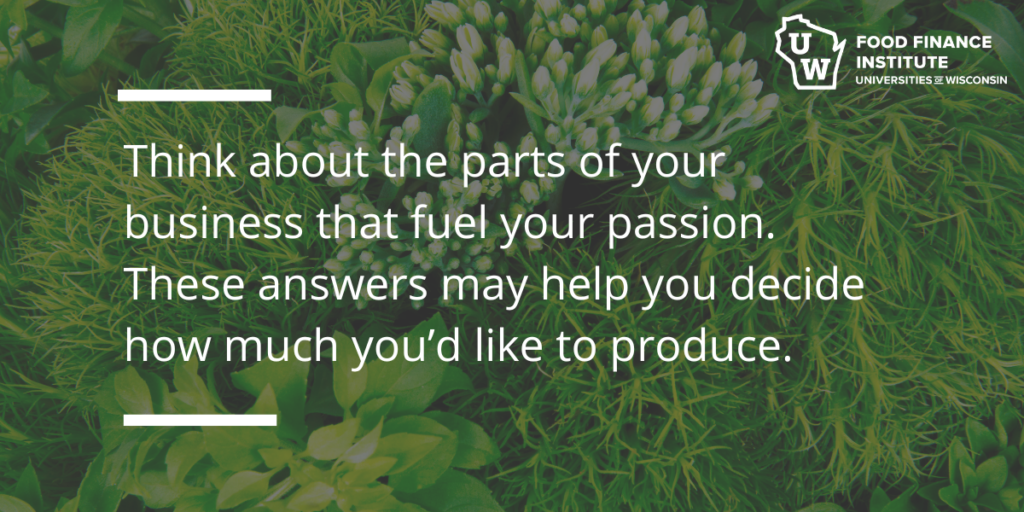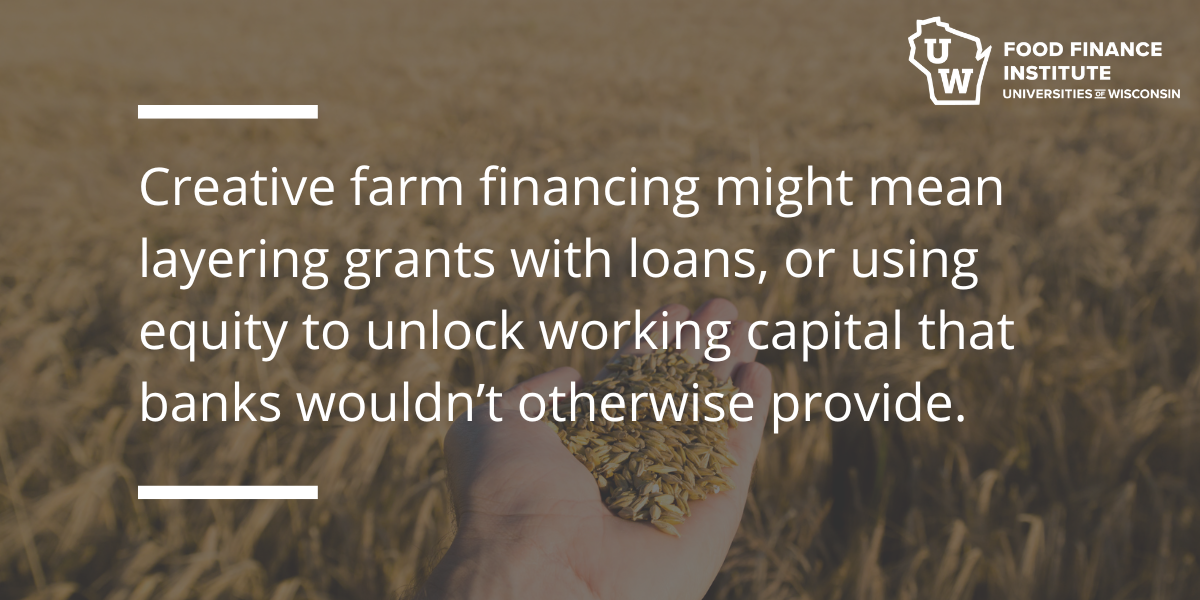by Anna Thomas, FFI Farm Finance Specialist
This blog is published in conjunction with a 2025 Marbleseed Organic Farming Conference roundtable on the same subject, led by FFI Farm Program Manager Andy Larson.
Whether you’re five years in your farm business, or five months, you might find yourself asking: what is the right scale for my farm? In this article we’re not necessarily talking about how many acres you’re working but figuring out what scale of production is ideal for your business goals.
This important question can be answered by asking yourself a few more questions: What do I want? This answer involves a little soul-searching. And then, what do I need? This answer is determined by putting paper to pencil and calculating some valuable financial data.
Start With These Questions
First, what do you want? Think about the parts of your business that fuel your passion. While being a business owner includes some decidedly unglamorous tasks, which work is most rewarding? Maybe it’s talking to buyers about your favorite recipes for your plump heirloom tomatoes or walking through the dewy grass to gather eggs. Or perhaps it’s figuring out the most economical way to triple-wash tender lettuce or guiding your crew to efficiently harvest snap peas.
These answers may help you decide how much you’d like to produce. If you love to be hands-on and talk to end consumers, being a smaller producer selling at the farmers market may be a perfect fit. If you enjoy working with employees and streamlining operations, you may be destined to grow to a larger scale, selling your vegetables or meat directly to other retailers or a distributor.
Intermediaries will take a bite of your profit margin, but you will be streamlining your efforts to sell and move product.
To summarize, if you prefer to sell less product, your cost of production will be higher, and you will traditionally sell direct-to-consumer with a higher margin. If you want to scale up, you can maximize your economies of scale and grow more for less, but you will sell all or a larger percentage of your goods as wholesale to buyers like stores, restaurants, or distributors. These intermediaries will take a bite of your profit margin, but you will be streamlining your efforts to sell and move product.
If you have an idea of where you’d like to end up, then it’s time to dive into your personal and business financials and figure out how to get there. If you need help getting started, finance workshops and trainings specifically for farm businesses are available at the online Food Finance Learning Center.
A Case Study: Cynthia’s Herbs
Let’s walk through an example of how your financial data can help you decide the right size for your farm.
Cynthia has been growing culinary herbs on a half-acre and selling them at a small farmers market on the weekends. Chefs have been coming to her stand more frequently because she grows some herbs that are not widely available. Cynthia is a teacher and does most of her work in her spare time, in the evenings, weekends, and summers. She’s wondering if she can expand the business so that she can grow herbs full time and leave her teaching job.
Here are some of the questions Cynthia needs to answer to figure out if she can grow herbs full time.
How much money does she need to make?
Cynthia needs to calculate her salary and the value of her benefits, and what those benefits will cost her without her current job (what will she need to pay for healthcare, etc.?) If this is the dollar amount Cynthia needs to quit her job, this is the amount of money she needs to be able to draw from the farm business over the course of a year. (Other people may have a partner with an off-farm salary and benefits, so their goal may be to break even.)
What is the current profit margin for Cynthia’s farm?
This type of question can feel overwhelming, but it is critical information to know no matter what size of farm you have or want. Cynthia needs to have a spreadsheet that has accurate details of the variable costs of what she grows (these are the costs that change with the amount produced) and her overhead expenses (these are the costs that don’t change with level of production, like insurance, advertising, or repairs).
What is the gap between what Cynthia currently earns at her job and her farm profits?
How much does her production need to increase to cover this cost? If she currently sells one bunch of herbs for $5 and her net profit is $1, how many additional bunches does she need to sell to farm full time?
Once she has this information, she can make an informed decision if she wants to grow, and more importantly, is it possible to grow her farm business to that scale?
Whether it is possible will involve more data and research for Cynthia. She will need to figure out what her scaling opportunities are and what sales channels are good options. She will need to identify her target market and if they live nearby. Are there more or larger farmers markets she can attend? Is there a bigger metropolitan area nearby where she can sell her herbs? Could she be an add-on to another farm’s CSA? Is there a restaurant distributor looking for the types of herbs she grows? Does she want to market and deliver directly to restaurants? Will she need to hire any employees? Will her per unit profitability change because she can buy supplies in bulk for a lower cost?
Answering the above questions will help Cynthia project her future revenue and costs to see what scale allows her to farm full time.
If you need guidance answering your farm financial questions, creating a business plan, or creating financial statements to secure capital, help is available through FFI training and consulting.


